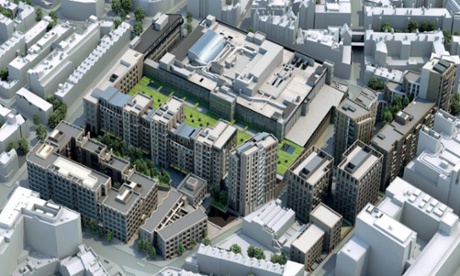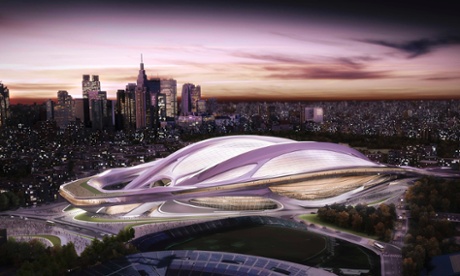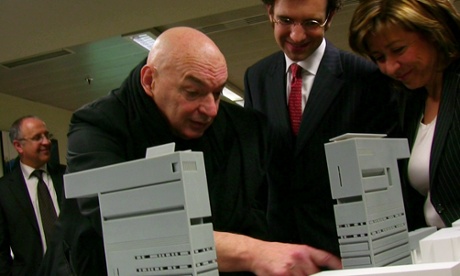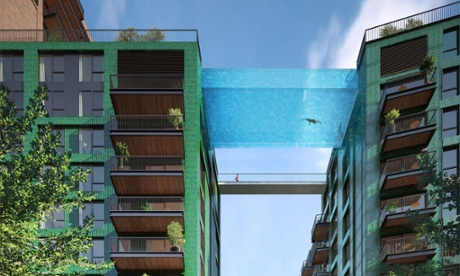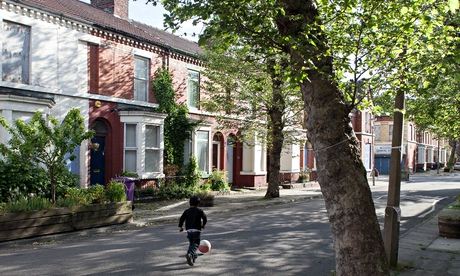What do a fake hill, a giant light-up ball, gondola rides 300 metres in the air, staircases to nowhere, a park perched over a river and a glass elevator stuck on the side of a skyscraper have in common?
They are all part of the experience-ified modern city. The Mound, London’s sad, artificially turfed scaffolding structure, could soon be joined by the Sphere and the Tulip, while New York already has Vessel, Little Island and Summit One Vanderbilt.
Major cities are on a roll, commissioning giant and peculiar structures for the purpose of attracting consumers by providing a unique experience. This trend isn’t so much a stylistic movement as an expression of financial pragmatism. Designers, however starry eyed, are beholden to the interests of their clients.
Take the Mound, commissioned by Westminster council and designed by the Dutch firm MVRDV. The aim was to bring people back to shop on Oxford Street and turn a prime piece of central London land into a paid attraction. The scheme didn’t quite go to plan, and eventually the site had to offer free entry to draw in visitors.
It was the same thinking behind the British designer Thomas Heatherwick’s Vessel, a 46-metre (150 ft)-high viewpoint costing $200m (£144m), built to increase footfall in Manhattan’s Hudson Yards luxury shopping district. Unfortunately, the visible and accessible high place also attracted suicides. The Vessel closed for several months earlier this year after the third death, reopening with a requirement that people have to buddy up in groups of two to enter. In July, a 14-year-old boy died after jumping in front of his family. Now it might close for good.
Just a few blocks away, in midtown Manhattan, the Summit is due to be opened next month by SL Green Realty. The skyscraper promises to draw people straight out of Grand Central station with a vertiginous bar, an infinity mirror room made for selfies, and glass bottomed overhangs. The whole tower cost $3.3bn to build, and ticket prices (the glass elevator ride is separate, of course), have yet to be announced.
The Tulip, which awaits a final planning decision, is perhaps the most bizarre on paper. Raised 305 metres over the City of London on a concrete pole, the bulbous pod – commissioned by the Safra Group, designed by Foster + Partners – will include rides and slides located on the outside of the building. It’s not just land that is now being monetised, it’s the airspace around it.
These buildings first entered our cities in the form of the funfair structures of the millennium: the giant ferris wheel of the Eye and the circus big top of the Dome. Definite articles were added to their names, emphasising the supremacy of the attractions. The financialisation of property that occurred over the following decades caused developers to seek profits by buying and selling land at inflated prices. Caught in a trap of their own making, they were forced to monetise commercial properties in order to make greater returns on increasingly expensive assets. Ironically, they’re having to draw people back to the neighbourhoods they priced them out of.
If the main purpose of these experience-led attractions is to make cash for their developers, it’s unsurprising that they are actively making our cities worse – and not just aesthetically. Little Island, dubbed “the Instagram park”, and also designed by Heatherwick, is a wonderland of trees and plants cupped by concrete columns rising out of the Hudson River. It cost the billionaire Barry Diller $260m to build and, although it is free, you have to reserve a slot in advance. Diller said he paid for round-the-clock security, ostensibly to prevent a repeat of the problems at Vessel.
The joy of impulsivity is gone if you have to pre-register your personal data for a park. Discovery is no longer a welcome accident of wandering when security barriers obstruct your way, and spaces are no longer public if we’re only allowed to walk them under the gaze of security guards.
It doesn’t have to be this way. People don’t want to live in a privatised playground: they want a city that actually inspires them, and which works. And it isn’t sanctimonious to suggest that free public amenities can actually be sexier as attractions. Just see Oodi, Finland’s stonking Helsinki central library, by ALA Architects, or the Nippon Foundation’s Tokyo Toilet Project, where big names such as Tadao Ando and Toyo Ito have designed public loos that light up or go see-through when not in use. Just imagine what Norman Foster could do with a couple of million for a toilet, instead of the Tulip.
India Block is deputy editor at Disegno, a quarterly design journal
In the UK and Ireland, Samaritans can be contacted on 116 123 or email jo@samaritans.org or jo@samaritans.ie. In the US, the National Suicide Prevention Lifeline is 1-800-273-8255. In Australia, the crisis support service Lifeline is 13 11 14. Other international helplines can be found at www.befrienders.org.




